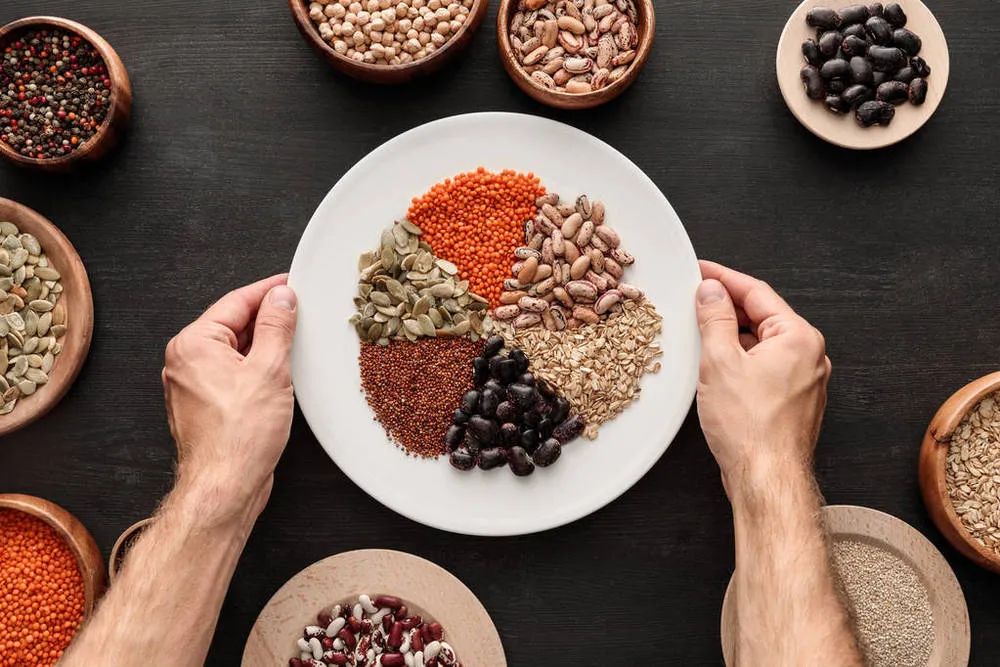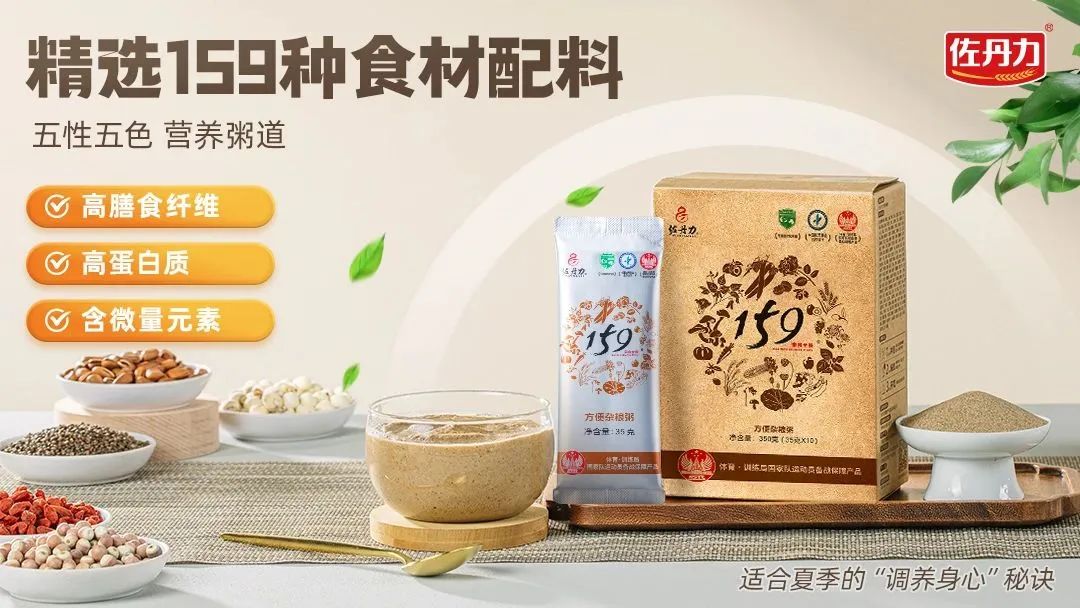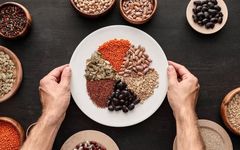
Over two thousand years ago, the “Huangdi Neijing” proposed the dietary principle that “grains nourish, fruits assist, and combining flavors supplements essence and energy“. The ancients believed that whole grains nourish the five organs: soybeans primarily nourish the kidneys, rice moistens the lungs, millet nourishes the spleen, sorghum nourishes the liver, and wheat nourishes the heart.
In modern terms, whole grains do not refer to specific five types of grains, but are commonly used to refer to grains other than rice and flour, and whole grains generally refer to cereal crops, thus encompassing all grains.
Today, we summarize and introduce the health benefits and nutritional values of several common whole grains. Be sure to bookmark this!
1. Millet: Harmonizes the Middle, Strengthens the Spleen, and Clears Heat
Those from the north may be most familiar with millet, also known as sorghum. Traditional Chinese Medicine (TCM) considers millet to have a sweet and salty flavor, slightly cold nature, and functions to harmonize the middle, strengthen the spleen, clear heat, benefit kidney qi, replenish deficiencies, and promote diuresis and reduce swelling. Additionally, millet made into crispy rice has a sweet and neutral flavor, functions to tonify qi and strengthen the spleen, and alleviate accumulation and diarrhea. Millet bran oil, made from millet husks, has effects of dispelling wind, killing insects, relieving itching, and astringing.
Compared to southern rice, millet generates more heat, and studies have shown that millet contains higher levels of iron, carotene, vitamin B1, and B2 than rice. Its rich tryptophan content is easily absorbed by the body, promoting the secretion of serotonin, making it an excellent food for sleep and digestion.
2. Sorghum: Nourishes the Liver and Benefits the Stomach
Sorghum is an indispensable supporting role among grains, with effects of nourishing the liver, benefiting the stomach, and astringing to stop diarrhea. Especially for those with chronic diarrhea, symptoms may improve after continuous consumption for a period. Sorghum can be processed into flour, cooked, and made into a thin porridge to be taken before meals, or made into sorghum buns, noodles, etc.
For children with weak spleen and stomach who do not like to eat, if they eat a little too much or consume something cold, they may experience diarrhea and bad breath. One can use 60 grams of shelled sorghum, roast it, and 10 red dates (pitted and roasted). Grind all ingredients into powder, and take one teaspoon mixed with warm water and an equal amount of maltose before meals once a day for about a week to see effects. The sweet taste makes it more palatable for children.
Children are in a state of developing yin and yang, with their spleen qi not fully developed, and they require stronger spleen qi for growth, just like a sapling needs fertile soil to thrive. This dietary therapy nourishes stomach qi and strengthens the spleen while also nourishing the liver, which can greatly benefit children with digestive issues and support their growth and development.
However, it is important to note that sorghum contains tannins that have astringent and anti-diarrheal effects, so it is not suitable for those with constipation.
3. Coix Seed: Strengthens the Spleen and Drains Dampness
Coix seed, also known as Job’s tears, has a cool nature, sweet and bland flavor, and enters the spleen, stomach, and lung meridians. It strengthens the spleen, drains dampness, clears heat, and stops diarrhea, and is used for edema, beriberi, urinary difficulties, and spleen deficiency diarrhea.
The most prominent effect of coix seed is its ability to promote urination and drain dampness without harming yin fluids. “Bencao Xinpian” states, “Coix seed is best at promoting urination without depleting true yin energy; for those with excess dampness in the lower body, it is most suitable. Depending on the severity of the illness, the dosage can be adjusted, ensuring that yin and yang are not harmed, and dampness diseases can be easily resolved.”
It is important to note that coix seed is cool in nature; when consuming, it can be stir-fried in a hot pan to remove its cold nature, thus enhancing its dampness-draining effect while preventing cold from harming the spleen and stomach.
Modern research has shown that coix seed has anti-tumor, immune-enhancing, and blood sugar-lowering effects. Cooking coix seed with rice or adding an appropriate amount of rock candy can increase appetite in cancer patients and reduce the side effects of chemotherapy.
4. Euryale Seed: Strengthens the Spleen, Drains Dampness, and Astringes Essence
Euryale seed has a sweet and astringent flavor, neutral nature, and enters the spleen and kidney meridians. It benefits the kidneys, astringes essence, supplements the spleen, stops diarrhea, and eliminates dampness. Clinically, it is commonly used to treat spleen deficiency diarrhea and kidney qi instability.
“Bencao Qiuzhen” states: “Euryale seed supplements the spleen due to its sweet flavor; it astringes the kidneys due to its astringent flavor. Its sweet flavor supplements the spleen, thus benefiting dampness, and can treat diarrhea and spleen pain; its astringent flavor astringes the kidneys, thus alleviating urinary incontinence and other issues.” This explains that euryale seed can simultaneously supplement the spleen and kidneys, benefit dampness, and transform turbidity, making it particularly suitable for those with spleen deficiency and dampness.
5. Buckwheat: Strengthens the Stomach and Increases Vitality
Buckwheat is one of the main grain varieties, originating in China, with a cultivation history of at least 2000 years. In the Warring States period, the “Shennong Book” listed buckwheat as one of the eight grains (millet, foxtail millet, rice, millet, hemp, beans, and wheat). Due to its rich nutritional content, buckwheat is recognized worldwide as a natural health food that combines nutrition, health care, and medicinal value, making it a “dual-purpose” grain.
TCM considers buckwheat to have a cool nature, sweet flavor, and enters the spleen, stomach, and large intestine meridians. “Bencao Gangmu” states: “(Buckwheat) strengthens the stomach, benefits vitality, replenishes spirit, benefits the eyes and ears, can cleanse the five organs of impurities, descend qi, and relieve constipation, and eliminate heat and swelling pain.” Buckwheat has effects of strengthening the stomach, increasing vitality, uplifting spirit, cleansing the five organs of impurities, and promoting bowel movements, primarily treating loss of appetite and gastrointestinal stagnation. Due to its significant cleansing effect, it is commonly referred to as “intestinal cleansing grass”.
It is important to note that those with spleen and stomach deficiency and cold should avoid excessive consumption, as well as those intolerant to wheat products.
6. Yellow Soybeans: Strengthens the Spleen and Relieves the Stomach
Yellow soybeans, or soybeans, are native to China and are considered the king of beans, with a neutral nature and sweet flavor, having effects of strengthening the spleen, relieving the stomach, and nourishing blood.
Modern research has found that soybeans are rich in estrogen-like isoflavones, lecithin, sterols, linoleic acid, plant sterols, and various essential amino acids, which can alleviate menopausal discomfort, atherosclerosis, promote nerve function, delay skin aging, lower blood lipids, and enhance immune function.
7. Oats: Astringes Sweat and Supplements Deficiency
Oats are also one of the “eight grains” and are known as hull-less oats due to their difficulty in hulling. Oats are a low-sugar, high-nutrition food. Many people who want to lose weight or focus on healthy eating consume oats, as they can remove facial blemishes, lower cholesterol, and achieve weight loss, while also regulating blood pressure and blood lipids, earning them the title of “plant gold”.
TCM considers oats to have a neutral nature, sweet flavor, and enters the spleen and liver meridians, with effects of stopping sweating and promoting bowel movements. Oats can astringe sweat and supplement deficiency; if experiencing spontaneous sweating or night sweats, one can cook glutinous rice and oats together to supplement deficiency and astringe sweat. “Hunan Materia Medica” records: “For excessive sweating: one ounce of whole oat grass, decoct in water, or add five qian of rice bran.” Oats have a laxative effect and are suitable for those with constipation.
Oats contain various nutrients, with fat and protein content 20 times that of rice, but with low calories; they also contain B vitamins, folic acid, calcium, and iron. Oats contain functional nutrients such as β-glucan, which has antioxidant and immune-enhancing effects.
It is important to note that due to the high dietary fiber content of oat flakes, those with gastrointestinal diseases such as gastric ulcers, duodenal ulcers, and esophageal varices should avoid excessive consumption. Oats also have a laxative effect, so those with diarrhea should also avoid them.
8. Brown Rice: Promotes Digestion and Aids in Digestion
Brown rice is obtained from unprocessed or minimally processed whole grains after the husk is removed. It consists of bran, germ, and endosperm. Compared to white rice, brown rice retains a higher level of overall nutrition.
Although brown rice is rough, its nutritional value is very high, primarily reflected in the bran, which is what we refer to as rice bran. Li Shizhen in “Bencao Gangmu” stated: “Rice husk is rice bran, sweet, neutral, and non-toxic, primarily promoting bowel movements, opening the stomach, descending qi, relieving accumulation, and can nourish the body.” Rice bran helps to promote bowel movements and improve symptoms of indigestion and constipation.
Modern nutritional studies have also found that brown rice is suitable for obese and diabetic populations.
9. Black Beans: Nourishes the Kidneys and Strengthens the Waist
TCM considers black beans to have a sweet and neutral flavor, entering the spleen and kidney meridians, with effects of benefiting essence, brightening the eyes, nourishing blood, dispelling wind, promoting urination, and detoxifying.
Modern research has found that black beans are rich in oligosaccharides, saponins, anthocyanins, isoflavones, and various vitamins, which can help delay skin aging, hair loss, greying hair, lower back pain, kidney deficiency, hearing loss, and abnormal gynecological discharge.
In modern times, due to high work pressure, many people experience physical weakness and fatigue. To enhance vitality and energy, according to TCM theory, nourishing the kidneys is crucial. Beans are the grains of the kidneys, and black is associated with water, which nourishes the kidneys, so consuming black beans is beneficial for those with kidney deficiency. For young women, black beans also have beauty and skin benefits.
10. Purple Rice and Black Rice
Black rice is a precious variety among glutinous rice, ideal for dietary therapy for diabetes and cardiovascular diseases, and is a highly nutritious tonic. In “Dream of the Red Chamber”, it is referred to as “Imperial Field Red Rice”.
Purple rice and black rice, along with other purple-black grains, are generally rich in anthocyanins, which have antioxidant effects, can prevent fat oxidation, and maintain the health of ocular blood vessels.
11. Sesame: Nourishes the Liver and Kidneys, Benefits Essence and Blood
Ancient people referred to sesame as “food of the immortals”, and its health and longevity benefits have been recognized by medical practitioners throughout history. Sun Simiao, a longevity expert from the Tang Dynasty, stated: “Long-term consumption of sesame brightens the eyes and strengthens the tendons.”
Sesame, originally named Hu Ma (due to its origin in the Western Regions), comes in black and white varieties. The nutritional and functional properties of black and white sesame are basically the same, but black sesame generally contains more oil and has a richer aroma, making it more commonly used for oil extraction and having higher medicinal value.
TCM considers black sesame to have a neutral nature, sweet flavor, and enters the liver, kidney, and large intestine meridians, capable of nourishing the liver and kidneys, benefiting essence and blood, moistening the intestines, and alleviating dryness. It is commonly used for essence and blood deficiency, dizziness, tinnitus, premature greying, hair loss after illness, and constipation.
Modern research shows that black sesame is rich in calcium, containing 814 mg of calcium per 100g, while 100g of regular liquid milk contains only 104 mg of calcium, making black sesame’s calcium content more than seven times that of milk. Its rich calcium can nourish the kidneys and strengthen bones, greatly benefiting the prevention and improvement of osteoporosis in the elderly.
Additionally, black sesame contains linoleic acid, lecithin, sesamin, and sesamol, which are essential substances for brain health. Regular consumption of black sesame can improve brain function and enhance memory.
12. Wheat: Nourishes the Heart and Kidneys, Strengthens the Spleen and Blood
Wheat has a slightly cold nature and functions to nourish the heart and kidneys, strengthen the spleen and blood, and clear heat and quench thirst. “Suixiju Yinshi Pu” discusses its ability to supplement deficiency, strengthen the stomach, and enhance physical strength. Therefore, it is suitable for those who are weak after illness, have anxiety, insomnia, excessive dreaming, irritability, diarrhea, abdominal distension, and cold abdominal pain, as well as menopausal women.
It is best to choose coarsely crushed wheat, as wheat containing germ and bran is a whole grain food. Nowadays, wheat is often processed into cakes, pancakes, fried dough sticks, and other fried and baked foods, which are relatively hot and can easily cause dry stools, mouth sores, and dry throat symptoms. Additionally, cakes and fried dough sticks are high in fat and energy, so diabetic patients and those with high blood lipids and hypertension should avoid excessive consumption.
13. Corn: Regulates the Middle and Opens the Appetite
Corn has a neutral and slightly cool nature, sweet flavor, and enters the liver, kidney, and bladder meridians, with effects of draining dampness, strengthening the spleen, promoting urination, and benefiting the liver and gallbladder.
Notably, it has an appetite-opening effect. “Bencao Gangmu” states that corn “regulates the middle and opens the appetite”, while “Bencao Tuichen” refers to it as a “stomach tonic”. “Dian Nan Bencao” describes corn as “able to regulate the stomach and harmonize the middle, drain water and eliminate dampness, and clear heat and reduce fire”. Its appetite-opening effect primarily works through draining dampness and strengthening the spleen, making it especially suitable for those with thick and greasy tongues due to dampness or heat obstructing the spleen and stomach.
Modern research shows that corn can increase the number of beneficial bacteria in the intestines, improve digestive system issues, and enhance diet and bowel movements. Corn also has blood pressure-lowering and blood sugar-lowering effects, making it suitable for patients with hypertension and diabetes.
14. Mung Beans: Clears Heat and Detoxifies
Mung beans are a food and medicinal source, highly praised by ancient people. The Yuan Dynasty agronomist Wang Zhen praised mung beans as “a good grain for saving the world”, and the Ming Dynasty physician Li Shizhen referred to mung beans as “essential food”.
Mung beans have a wide range of uses in daily life: they can be cooked into mung bean porridge, steamed into mung bean rice, wrapped in mung bean dumplings, or brewed into mung bean wine; ground into fine powder, they can be made into mung bean paste, mung bean cake, mung bean noodles, and mung bean vermicelli. Notably, mung beans can be soaked in water to sprout (mung bean sprouts), which are a delicacy.
TCM considers mung beans to have a sweet flavor, cool nature, and enter the stomach and heart meridians, with effects of clearing heat, detoxifying, and promoting urination. The detoxifying effect of mung beans is primarily in the skin, while the detoxifying effect is in the flesh.
Mung Bean Skin Clears Heat and Relieves Irritation
Mung bean skin, also known as mung bean husk, is the seed coat of mung beans, with a sweet and cold nature, capable of detoxifying and relieving eye irritation. Its heat-clearing and summer-relieving effects are better than those of the flesh, so when using mung beans for summer heat relief, it is best to consume them with the skin. The Tang Dynasty physician Meng Shen stated: “Nowadays, people eat mung beans and remove the skin, which can cause some stagnation; if treating illness, it is essential to include the skin, and it must not be removed.”
Mung Bean Flesh Clears Heat and Detoxifies
Historical materia medica books emphasize the detoxifying effects of mung beans, such as “Bencao Fengyuan” stating: “Detoxifies aconite, arsenic, and various stone drug poisons.” It is recorded that mung beans can be used for food poisoning, herbal poisoning, alcohol poisoning, metal poisoning, pesticide poisoning, gas poisoning, and zinc phosphide poisoning as emergency food.
Modern research shows that the detoxifying effect of mung beans comes from components such as mung bean protein that precipitate with organic phosphorus and heavy metals, so when using mung bean soup for detoxification, it is best to cook the beans until soft (but not overcooked), and consume the beans along with the soup. This mung bean soup, although cloudy, has a stronger heat-clearing and detoxifying effect. Sometimes, to enhance detoxifying effects, one can brew mung bean and licorice soup using 500 grams of mung beans and 30 grams of licorice, boiling with water until the beans are soft and flowered, then cooling and drinking as tea.
15. Red Beans: Nourishes Heart Blood
TCM considers red beans to reduce swelling and detoxify, clear the heart and relieve irritation, and replenish blood, while also providing potassium, magnesium, phosphorus, zinc, selenium, and other nutrients.
Li Shizhen referred to red beans as “grains of the heart”; red beans can clear heart fire and nourish heart blood. Additionally, red beans are rich in coarse fiber, which helps lower blood lipids, lower blood pressure, and improve heart function.
16. Peanuts: Strengthens the Spleen and Stomach, Moistens the Lungs and Resolves Phlegm
It is said that “regular consumption of peanuts can promote health”. Peanuts are rich in nutrients, with nourishing and longevity benefits, suitable for all ages, and are commonly referred to as “longevity fruit”. Their protein content can rival that of animal foods like eggs and milk, earning them the reputation of “plant meat” and “vegetarian meat”.
TCM considers peanuts to have a neutral nature, sweet flavor, and enter the spleen and lung meridians, with effects of strengthening the spleen, harmonizing the stomach, moistening the lungs, resolving phlegm, moistening the intestines, and promoting lactation, suitable for malnutrition, spleen and stomach disorders, cough with phlegm, and insufficient milk supply.
“Bencao Gangmu Shiyi” states: “Peanut kernels are sweet and fragrant, can strengthen the spleen and stomach, and are suitable for those with difficulty digesting food.” The Ming Dynasty physician Lan Mao recorded in “Dian Nan Bencao” that boiled salted peanuts treat pulmonary tuberculosis; roasted peanuts invigorate blood circulation, treating abdominal cold accumulation and pain. Folk sayings state that “raw peanuts strengthen the stomach, boiled peanuts moisten the lungs, and roasted peanuts protect the liver”, consistent with ancient discussions.
17. Sweet Potatoes: Benefits Qi, Generates Fluids, and Promotes Bowel Movements
Sweet potatoes, also known as yams, are a common ingredient in daily life.
Sweet potatoes are not only delicious but also a highly nutritious natural tonic. TCM considers sweet potatoes to have a sweet flavor and neutral nature, with effects of replenishing the middle, nourishing blood, benefiting qi, generating fluids, promoting bowel movements, and relieving constipation. “Suixiju Yinshi Pu” states that they “are cooked to nourish the spleen and stomach, benefit qi, and ward off wind and cold, enhancing complexion”.
Modern research has found that sweet potatoes are rich in protein, fat, polysaccharides, phosphorus, calcium, potassium, carotene, vitamin A, vitamin C, vitamin E, vitamin B1, vitamin B2, and eight essential amino acids.
Among these, the protein content of sweet potatoes exceeds that of rice by seven times, the carotene content is 3.5 times that of carrots, and the vitamin A content is 100 times that of potatoes, with sugar, calcium, and vitamins B1 and B2 also higher than those in rice and flour.
18. Fava Beans: Benefits Qi and Strengthens the Spleen
Fava beans, also known as broad beans, are one of the oldest edible bean crops.
TCM considers fava beans to have a sweet flavor and neutral nature, entering the spleen, stomach, and liver meridians, with effects of benefiting qi, strengthening the spleen, brightening the eyes, dispelling liver stagnation, and promoting dampness and harmonizing the stomach. “Bencao Congxin” records that fava beans can “benefit the middle, enhance qi, astringe essence, and strengthen the intestines.”
Fava beans are neutral and sweet, suitable for all ages, and are commonly consumed in spring and summer. There is a folk custom of “tasting the three fresh foods on the day of the beginning of summer”, and fresh fava beans are one of them. At the end of spring and beginning of summer, seizing the opportunity to eat low-calorie fresh fava beans not only provides rich nutrition but also benefits qi, strengthens the spleen, promotes dampness, reduces swelling, nourishes the liver, brightens the eyes, and strengthens the kidneys. The saying “eating three qian of beans daily, no need for medicine for years” illustrates the health benefits of fresh fava beans.
19. White Hyacinth Beans: Strengthens the Spleen and Transforms Dampness
White hyacinth beans have been a dual-purpose food and medicine since ancient times, with a sweet flavor and slightly warm nature, entering the spleen and stomach meridians. They have effects of strengthening the spleen, transforming dampness, and harmonizing the middle to relieve summer heat. The Ming Dynasty physician Li Shizhen recorded in “Bencao Gangmu” that “hard-shelled white hyacinth beans are full, white with a slight yellow hue, have a fragrant aroma, and a warm and neutral nature, harmonizing the middle, benefiting the spleen, and can clear turbidity and eliminate dampness, thus treating summer heat and detoxifying. They can stop diarrhea and relieve summer heat, warming the spleen and stomach.”
White hyacinth beans can strengthen the spleen and transform dampness to harmonize the middle; although slightly warm, they do not have the adverse effects of warming and drying, so they can be used for summer heat and dampness-related diarrhea.
【Source: This content is a comprehensive summary from Zhang Qicheng, Huang Suiping’s discussions on the spleen and stomach, Xu Youjia’s parenting hall, reading TCM, Chinese Herbal Medicine Journal, and TCM teacher Pan Yi’s WeChat public accounts】

▲ Click the image above to enter the mini-program mall

Some images and texts are sourced from the internet, with respect to the original authors. If there are any questions, please contact us for proper handling. Contributions are welcome; please send to the email: [email protected]
▼Click “Read the original text” to enter the mall

